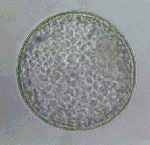 By now, most people in the breeding industry know what embryo transfer (ET) is however there is still a little confusion or misconception. I would say that the increased use and knowledge of in vitro fertilization, popularly referred to as ICSI (Intracytoplasmic Sperm Injection), has led to some of this confusion. We hear people interchanging the words embryo and egg as if they are the same thing. Let’s take a minute to draw a simple distinction between the two procedures.
By now, most people in the breeding industry know what embryo transfer (ET) is however there is still a little confusion or misconception. I would say that the increased use and knowledge of in vitro fertilization, popularly referred to as ICSI (Intracytoplasmic Sperm Injection), has led to some of this confusion. We hear people interchanging the words embryo and egg as if they are the same thing. Let’s take a minute to draw a simple distinction between the two procedures.
The Difference Between Embryo Transfer and ICSI
With embryo transfer, conception (fertilization) is taking place in the donor mare. This is accomplished through normal means of insemination or natural service. Between six and half and eight days later the uterus of that mare is flushed to recover the conceptus or embryo and it is then transferred to the recipient mare (or can be frozen for future transfer).
When using the ICSI procedure, the egg (oocyte) is harvested from the follicle on the mare’s ovary and that egg is fertilized with the injection of a sperm cell in the laboratory. The resulting conceptus is then nurtured and grown in the laboratory until it is approximately at the stage of a six to seven day embryo. It is then transferred to a recipient mare to carry that pregnancy to term.
So with one process, fertilization is taking place normally and we are harvesting an embryo (ET) and the other we are harvesting the egg prior to breeding the mare (ICSI). Our topic in this article is embryo transfer so we will leave the egg harvesting and in vitro fertilization for another day. However, for more information about harvesting equine eggs you may read our article, Ovum Pickup in the Mare.
Why Consider Embryo Transfer?
The simple answer is to benefit from your mare’s genetics. Embryo transfer provides us options to achieve those benefits in different ways or for different reasons. Such reasons may include maximizing the foal crop of a single mare, the ability for performance mares to produce foals, make it possible to produce foals from mares unable to carry their own offspring due to physical limitations and/or obtain healthy foals from mares who can’t carry their own foals to term.
Maximize the Foal Crop From a Single Mare
 A single mare, that is reproductively healthy, is capable of producing several embryos in the same year. This same mare could even produce one or more embryos for transfer and then carry her own foal that same year. Obviously, this can greatly maximize the genetics of a single mare, especially if done on repeated years.
A single mare, that is reproductively healthy, is capable of producing several embryos in the same year. This same mare could even produce one or more embryos for transfer and then carry her own foal that same year. Obviously, this can greatly maximize the genetics of a single mare, especially if done on repeated years.
Allow the Performance Mare to Produce Foals
The filly or mare that is still in performance is seldom able to carry her own foal. But through embryo transfer it is usually very easy to work around training and show schedules in performing the reproductive exams and procedures entailed in embryo transfer, thus allowing this mare to produce progeny before retiring from competition. For more information about ET for the competition mare see our article, Balancing the Show and Breeding Careers of an Embryo Transfer Mare.
Mares Unable to Carry Their Own Foal Due to Physical Maladies
Mares with various lameness issues for instance may not be the best candidates to deal with the heavy weight of a term pregnancy. There are various other health issues that make your mare a bad candidate to carry her own pregnancy. Many times conception is not an issue with these mares and a healthy embryo may be flushed allowing another mare to do the work of pregnancy and nursing the foal.
Reproductive Problems that Prohibit Carrying a Foal to Term
Two common problems that put mares in this category are cervical tears and aging changes of the uterus. These uterine changes are often revealed through repeated abortions or are diagnosed via uterine biopsies. Both of these categories of mares can often conceive and nurture an embryo long enough to allow successful transfers.
Another category of reproductive dysfunction that is a little more challenging are those with chronic endometritis (uterine infection). With some of these mares eliminating the infection to allow for a fetus to reach term is not possible but controlling the uterine environment long enough to harvest a seven day embryo can be. That embryo then has the ability to develop in the normal uterine environment of the recipient mare.
Frequently Asked Questions About Embryo Transfer
Questions certainly arise about the safety of the embryo transfer process for the donor mare. The procedure carries very little risk, certainly less than pregnancy and parturition.
How Many Embryos Can I Get From a Mare?
That is dependent on the fertility of the mare and the fertility of the stallion (or semen). As stated above, mares of normal fertility when breeding to fertile stallions, have the capacity to produce several embryos per year. In some instances this may be as many as six to eight.
Can I Get More Than One Embryo at a Time?
At this time there is no truly successful way to superovulate mares as is possible with other species such as cattle. There are hormonal therapies that can be employed in the mare but they are expensive, on average have very limited success and the drugs needed for superovulation are no longer available. However, some mares will double and even triple ovulate on their own and when that occurs two and rarely three embryos can be recovered.
Even if the Procedure is Safe, is There Any Risk to My Mare’s Reproductive Health by Repeatedly Trying to Harvest Embryos?
The repeated process of embryo transfer, year after year, can take a toll on the reproductive capacity of a mare. This is magnified if she is flushed repeatedly in the same year, year after year. However, this varies greatly with the individual mare, some being much more tolerant of the process than others. It is fair to say though that most veterinarians that perform a lot of embryo transfers believe there reaches a point of diminishing returns in doing repeated flushes year after year. In other words, at some point the success rate will begin to decline. Many of those same veterinarians believe these mares (used repeatedly for embryo flushing) can be helped by allowing them to occasionally carry their on foal to term. The process of full term pregnancy and delivery will allow the uterus and cervix to undergo changes that can be positive for their reproductive health.
Embryo transfer is certainly not for every mare nor every situation. However, it can be a way to maximize the investment made in the genetics of your mare or in some instances the safest or only way for a mare to still produce foals. Please contact one of our SBS Affiliate Labs for additional information about their embryo transfer services and visit our article, Choosing the Right Recipient Herd.


Log in to join the conversation.